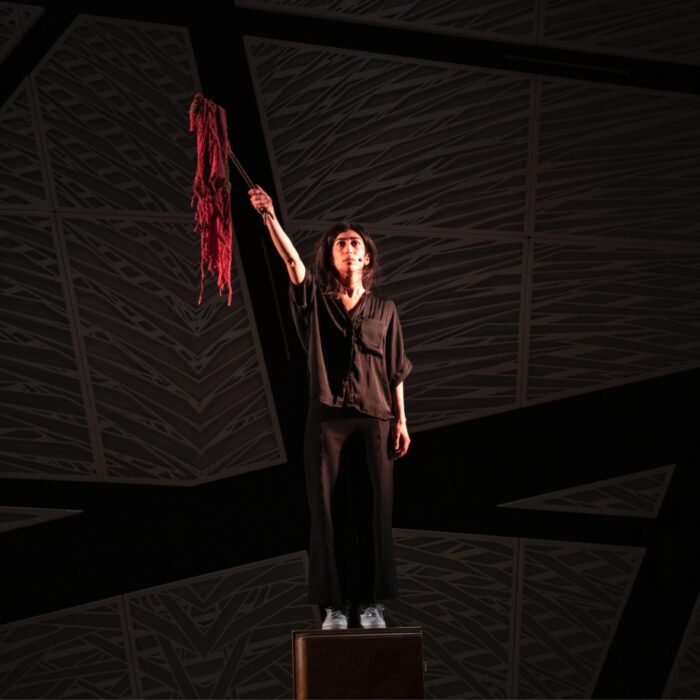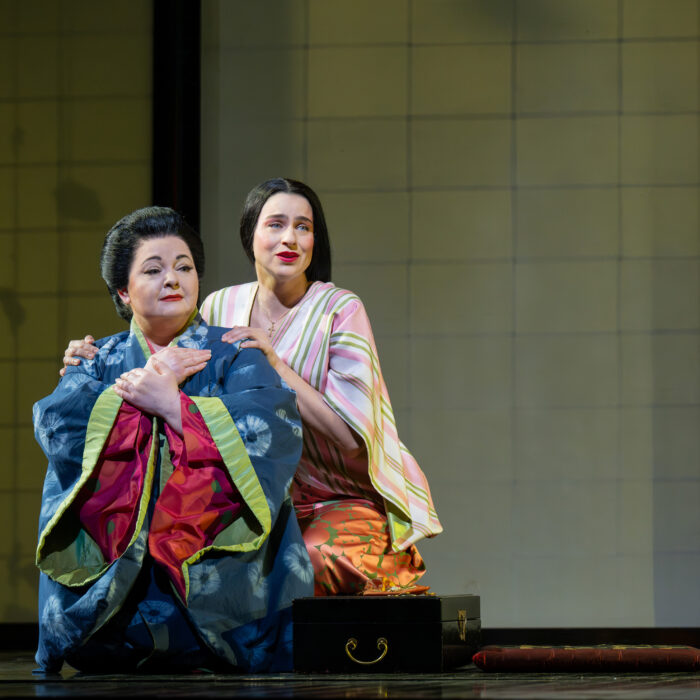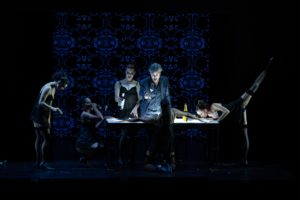
Teatro Mayor 2020 Review: Don Giovanni
Nahuel di Pierro Saves Marcelo Lombardero’s Incoherent Production
By Francisco SalazarOn Feb. 25, 2020, the Teatro Mayor in Bogota debuted a new production of Mozart and Da Ponte’s “Don Giovanni.”
“Don Giovanni” is one of the most controversial yet relevant operas of today. It is an opera that tells the story of a man who abuses women and gets away with it, all while mocking them. Given the social context, this opera seems like the one any director would be able to analyze in light of the #MeToo movement. But this is not the case with this production, which while set in modern times, comes off as a stereotyped vision with little to no insight with the primary focus aimed at generating shock value.
The result was an evening filled with distracting direction and a completely miscast group of singers.
A Questionable & Confused Take
Marcelo Lombardero’s production at the Teatro Mayor was brand new to the theater and seemed to be interesting at the beginning with its eye catching projections and its dark sets. But as the evening went on, one realized that the director was only interested in shocking the audience showing a modern world where women sell themselves to men or are too weak to resist them. In many ways, their over-sexualization makes them come off as the ones in control, essentially releasing Don Giovanni and the other self-absorbed men from any responsibility for the actions that unfold.
Take the character of Zerlina, who is overly sexualized from the start. Obviously her sexuality should not be a cause for concern as she has every right to be portrayed as such. But its her, not Don Giovanni, who makes the move. In “La Ci darem,” it isn’t Don Giovanni who seduces her but Zerlina who gives him suggestive looks. Then in the party scene at the end of Act one, Zerlina is dressed in a white wedding dress with her garter belt visible. Throughout the scene, she insinuates sex with Don Giovanni and even leads him on. In this context, when he attempts to rape her, it seems as if the director were suggesting that she was asking for it.
Meanwhile, her relationship with Masetto only serves to further fuel this portrayal as her only objective with him is to provoke him sexually to nullify any discordance between them. When she realizes that Masetto is upset, she uses her body and sex appeal to win him back. In “Batti Batti” she allows Masetto to touch her breasts and go down on her. She also gives him oral sex at one point and by the end of the aria they are about to have intercourse. “Vedrai carino” is the same exact story.
Meanwhile, Masetto is portrayed as an abusive man who constantly hits Zerlina or attacks her physically and psychologically. He hits Zerlina on numerous occasions and only seems interested in sex with her during her two arias. That is best displayed at the party scene when Zerlina disappears. Masetto is taken by strippers, undressed and made out to look like he is having fun. He only shows interest in Zerlina when he realizes that Don Giovanni has taken her. The end result is a character who only cares about his honor and to show he is a tough guy rather than a loving and caring young man.
One of the most boggling and uninteresting characters in this production is Leporello. Typically one of the most interesting in the entire opera, in this production he is left to look at an iPad throughout the evening and record videos as a voyeur. There are several times when he takes abuse from Don Giovanni but is content to snort cocaine with him and is also happy to record any sexual encounters with his master.
Then there is Don Ottavio and Donna Anna, who have no personality in the production. They stand immobile, look angry and when walking around have no motivation. One almost feels like the opera could do without them entirely.
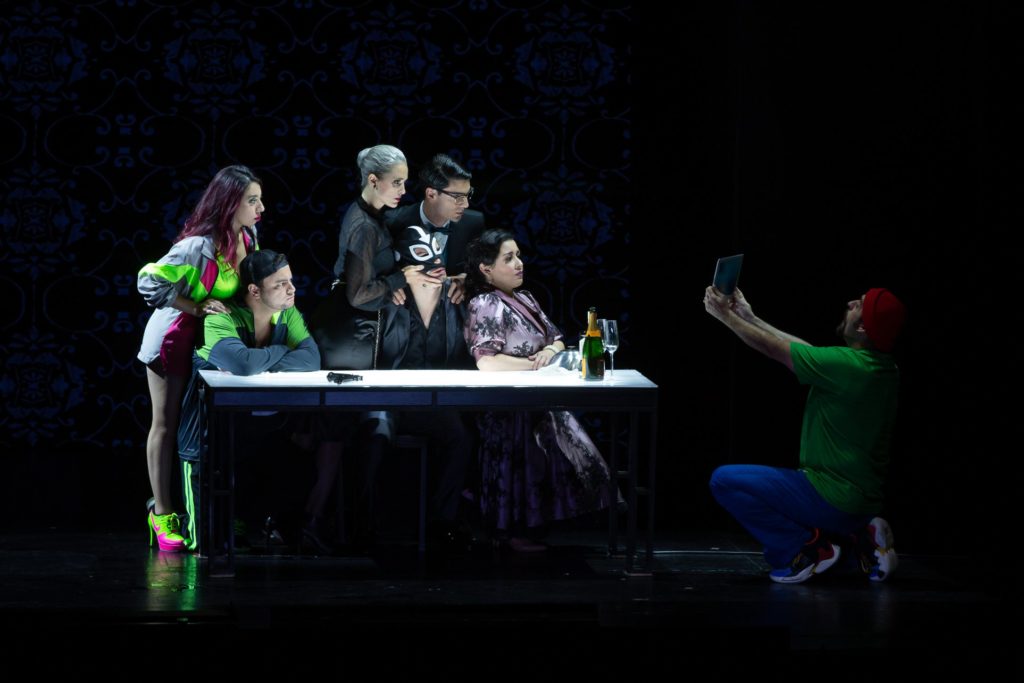
Distractions Galore
The sign of a good director is one that trusts the music and what is being presented with text. Lombardero clearly couldn’t trust the music as he was more interested in presenting distractions at each step of the First act. Dividing the stage into a vertical quadrants, there were always two things happening at once. For example during Donna Elvira’s opening aria “Ah, chi mi dice mai,” Lombardero had the character sing her aria on stage left while on stage right Don Giovanni and Leoporello were in a bathroom peeing and washing their hands. At one point he even had Giovanni change clothes.
Then in the catalogue aria, Lombardero had images from the iPad projected on a screen showing multiple women. One didn’t really know what to pay attention to – the women, Leoporello’s advances on Elvira, or Elvira’s pain.
During the wedding scene with Masetto and Zerlina, the chorus came out with bright colored outfits that took the attention away from the leads. Even more incongruous, they danced salsa to Mozart’s music. It was hard to take that entire moment seriously particularly when Leoprello’s character was more interested in taking pictures on his iPad with chorus members.
One of the other distracting elements of the production was the constant use of video projections. During “Deh vieni alla finestra,” Giovanni sang to a house camera. One didn’t really know whether to look at the camera projected on stage or to the singer himself. There were also videos of Anna and Ottavio at a funeral but they looked so staged and poorly acted that it was hard to really understand the point of their existence in the production.
The worst offender came during the Giovanni-Commendatore climax as the Commendatore was projected on the screen but never explained what exactly he was – a vision or a ghost or just the TV. The faces that were shot for the scene were also comical rather than fearsome.
Costumes were also a distraction throughout the evening from the short skirts that Zerlina wore to the mismatching outfit by Leporello and the chorus’ party costumes which ranged from fruits to El Chapulin and Zorro. Anna, Elvira, and Ottavios’ masked outfit also looked like it had come from a completely different production that resembled a more traditional approach.
Another questionable moment in the production came in the finale scene when all the characters decided to take a picture with the corpse of Don Giovanni. It was incredibly inappropriate and farcical at best.
One of the strangest additions to the evening was the repetition of Beethoven’s Moonlight sonata which came up every time the Commendatore was mentioned. It added time to the already long work and was completely out of place. It also came off as a massive cliché for “horror and suspense.”
But even when Lombardero had no distractions, the production lacked energy and this was seen in Act two as the stage would go to black and the scene would change for every aria before revealing a new projected set. During these scene changes the singers would stand and sing, often looking lost as their eyes directed themselves toward the conductor. That predictability itself became a distraction. You knew that something else was coming up and that this aria was more of a perfunctory transition; this undercut the dramatic potential of each aria for the characters and made Act two feel endless.
It reflected the general feeling that the director was more interested in his concept than developing the characters themselves.
A Positive
While the production was mostly a miss, there were some interesting things to take away.
When Don Giovanni shoots the Commendatore, projections of blood splattered on the screen with a harsh bullet sound, creating great impact in the audience.
Then there were the visually dimensional projections which created each environment from the bathroom, to a bar, to an upscale house and an apartment building. Each were colorful and gave the sense that the environments were physically real.
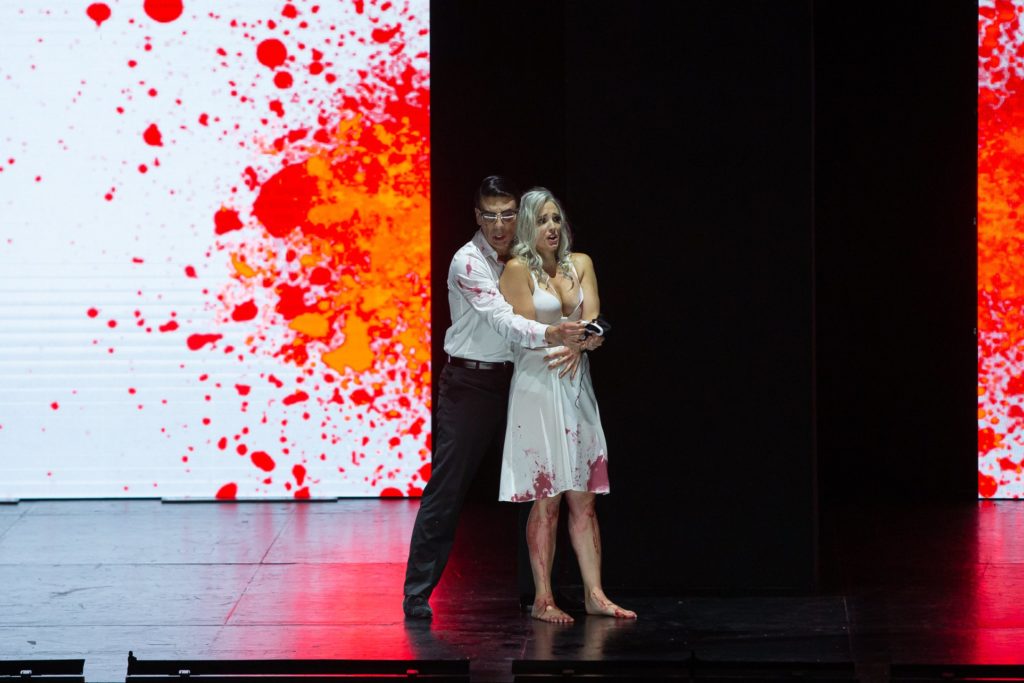
Miscast Singers
The cast didn’t fare any better throughout the evening even though they gave it their best.
In the role of Don Ottavio, Pablo Martinez demonstrated immaculate technique in both “Dalla sua pace” and “Il mio tesoro.” There was clean and polished phrasing and astonishing breath control during the coloratura line in “Il mio tesoro” and it was admirable to hear him sing the line without a breath.
But ultimately it all felt like an effect rather than something moving or expressive as both the arias require. His voice also missed the low notes making his timbre hollow. In the ensembles such as the trio at the end of Act one and the sextet in Act two, the tenor was difficult to hear.
The other big issue with Martinez’s performances was that his Don Ottavio had no personality. While Don Ottavio is not the most interesting of characters in the opera, there should have been a clearer perspective on who he is and how he behaves in this world. While this mostly falls on Lombardero’s lacking vision, Martinez was stiff the entire evening with his movements feeling mechanical.
As Donna Anna, Oriana Favaro also suffered the same fate as Martinez. Her voice while pretty and colorful, is thin and was constantly overpowered. In many ways her voice could not sustain the dramatic or full lyric line that Mozart wrote for this character. That was most noticeable in her first aria “Orsai, chi l’onore.” While Favaro sang each note with a clean sound, she did not ignite the aria with fury or power, often sounding cautious. The aria repeats “Vendetta” many times and the soprano never emphasized or phrased it differently. It almost felt as she was trying to get through the aria unscathed.
The thinness in her voice was heard throughout the evening, especially in the Act one trio as well as in the Act two sextet. In passages where she should have carried the ensemble her top notes became strident and flat.
But in her second aria “Crudele?…Non mi dir,” Favaro sang the first part with a gorgeous legato that almost had a silk-like quality. The lines connected with sheer beauty and one almost felt the pain and torment in Donna Anna. Unfortunately as she arrived to the cabaletta portion, her voice struggled with the coloratura and her high register thinned out. That ultimately led to an aria lacking in a climax.
Favaro’s characterization also lacked much depth. Only in the opening scene did she give a glimpse of madness at the sight of her father’s body. One could sense a mentally unstable and psychologically affected character. However, after this first scene, Favaro’s character was sidelined to making stock gestures, waving her hand or looking angry. One never really felt Donna Anna as much of a character, but instead a body on stage singing.
As the Commendatore, Ernesto Morillo brought a booming bass that created a frightening aura in the final scene. However, the video projections of his face at the end were a bit awkward and incomprehensible.
As Masetto Juan David Gonzalez was solid singing the patter lines with accuracy in his brief aria and bringing a sonorous sound to the auditorium. The one drawback to Gonzalez’s performance was he was not particularly audible when he was accompanied by ensembles.
Paola Leguizamon’s Zerlina as noted was unlikable and ultimately a contradiction. Vocally she has a dark lyric mezzo with good volume that carries well. Her coloratura line is even and her phrasing precise. But it is almost too safe to ignite any real sentiments. “Batti Batti” and “Vedrai Carino” were sung with care and proper phrasing that were appropriate to Mozart’s music.
Hernan Iturralde’s Leporello showed a promising if uneven voice. His opening lines in the opera revealed a strong and focused bass-baritone that carried well. And that was evident throughout the evening as he sang with sturdy tone, particularly in his patter lines. His diction was also outstanding in the recits making for compelling dialogues between his Leporello and Don Giovanni.
But in “Il catalogo e questo,” he disappointed. The opening was sung with aplomb and virtuosic charisma, but in the second part of the aria, the bass-baritone’s sound became thin and he seemed to run out of breath in the longer lines. It made for an uneven and distracting aria.
Two Highlights
As Donna Elvira, Marcela Chacón had a strong night. The soprano does not have a stable top register as it becomes strident and lacks the strength to float a note. That was most evident in all the ensembles and during “Mi Tradi.” Nevertheless, she was truly compelling with the use of the text, biting into each moment of anger and then truly conveying the pain of her character. Her “Ah, chi mi dice mai” was sung with force and command and showcased an unstable but fierce woman.
Her second aria “Ah! fuggi il traditor!” was also pulled off with incredible coloratura control and with power. In the Act one quartet “Non ti fidar, o misera,” each line was given a different color and she portrayed an angry yet suffering woman as she repeated the line “Ah non credete al perfido!”
Her “Mi Tradi” was another highlight of the evening as there was clear torment between the opening lines and the repetition of the A verse. One could feel a woman on the verge as she sang the roulades with delicacy, and even if they were not always accurate, there was always an expressive quality to it.
In the pit Jose Arean turned in a solid performance, conducting with agile tempi and always moving the music forward. From the overture onward, there was always precise dynamics and articulation that made the music fluid. He was also able to hold each ensemble together, creating cohesion.
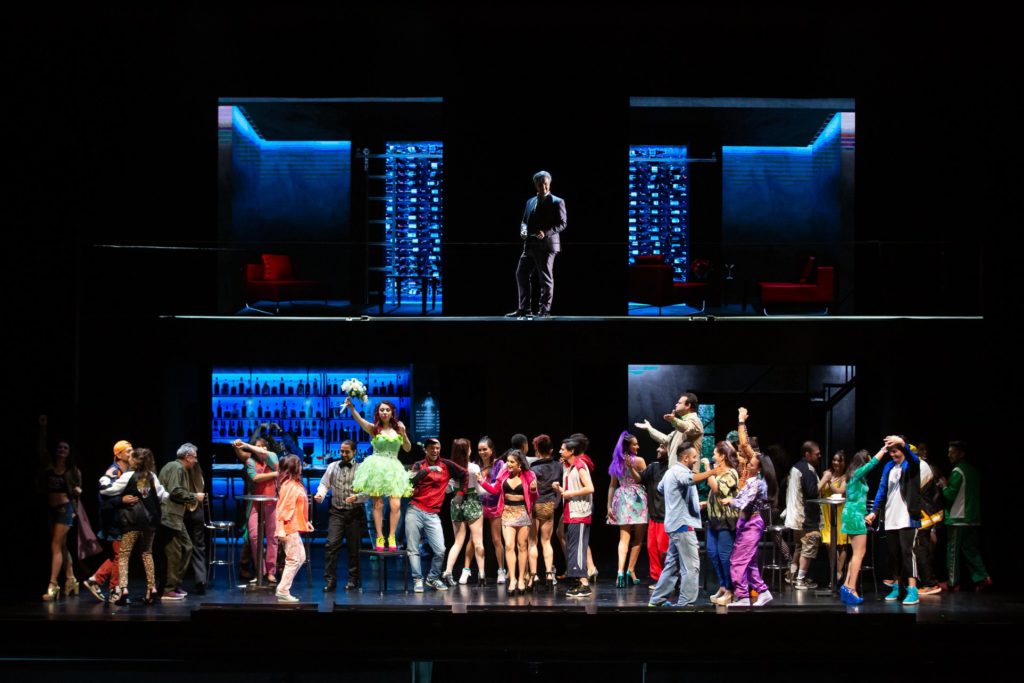
The Star
The star of the night was without a doubt Nahuel di Pierro.
From the moment he entered the stage he was in command of the production with his Don Giovanni eliciting charisma and danger. From his interaction with each of the women to his manipulation in Act two, Di Pierro was unstoppable. One could not look away for a moment for fear of missing his next action. One moment he was changing clothes and the next moment he was dancing alongside the chorus.
At another moment he would be serenading and being playful with the mariachi guitarist before sitting down to snort coke and have some oral sex. The unpredictability continued to come as he threatened to commit suicide at the end of the first act and then beat up Masetto in Act two. Those elements really gave energy and moved the story along.
In the musical moments he was also superb. His “Deh vieni alla finestra” was a vocal highlight as he brought suavity and warmth to his lyricism that was both tender and charming. The lines connected with flexibility and he was able to float the notes with ease and gorgeous ringing tones.
“Fin ch’han dal vino” was virtuosity at its finest as he pattered each verse with authority and command. His breath never seemed to run out and the accents on certain words were finely articulated.
The final scene with the Commendatore was also commanding and astonishing as his voice suddenly grew in size. His bass-baritone boomed as he challenged the Commendatore and defiantly sang the lines “No.” But throughout the scene this Giovanni went mad, ultimately commiting suicide. It was quite astonishing to see Di Pierro’s character turn from confident and cocky as he played with the women to mad and clearly under the influence as he saw the “vision” of the Commendatore.
Overall this was a rather disappointing evening despite its star, as it was marred by an incoherent production.
